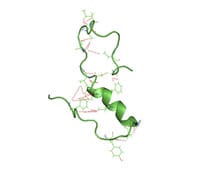A new molecular structure, developed by the University of Washington and other laboratories, could stop the progression of Alzheimer’s and related diseases.
Gene Hopping, a research scientist at the University of Washington, and others discovered a peptide that inhibits a type of toxic molecule involved in diseases like Alzheimer’s, Parkinson’s, heart disease, Type 2 diabetes and Lou Gehrig’s disease (2).

The new peptide is aimed toward inactivating toxic forms of Beta-Amyloid, shown above, and related structures.
Source: Wiki Commons
The peptide is complementary to a common structure in amyloid diseases, diseases including Alzheimer’s that involve amyloids, or insoluble fibers that can be deposited on organs or tissues, disrupting function.
In amyloid diseases, the soluble form of amyloids is more toxic than the fibers (2). The newly discovered peptide targets the soluble form, also called a toxic oligomer or amyloid-derived diffusible ligand. In the case of Alzheimer’s disease, according to the amyloid theory, the toxic soluble form results when Beta-Amyloid (Aβ) peptides fold incorrectly, which causes other Aβ molecules to fold incorrectly in a chain reaction. Researchers believe the soluble form to binds to neurons and changes synapse structure detrimentally, as well as causing neurons to die in other ways (3).
Hopping identified a common structure called an alpha-sheet, similar to the beta-pleated sheet, in these toxic soluble molecules (2). The common structure allowed him to develop a peptide that binds the alpha-sheet, inhibiting the toxic effect of the soluble form.
The application of the protein blocker to the toxic oligomers of a group of amyloids makes this finding unique, as it targets a structure common in all of them.
“What’s critical with this and what has never been done before is that a single peptide sequence will work against the toxic versions of a number of different amyloid proteins and peptides, regardless of their amino acid sequence or the normal 3-D structures,” said Valerie Daggett, a University of Washington professor of bioengineering (1).
The research on the peptides began in Dagget’s lab almost a decade ago when a former graduate student discovered the alpha-sheet structure through computer simulations.
A patent for the alpha-sheet peptide has been created and further patents for a related batch of compounds are pending (1).
References
1. Ma, Michelle, New protein structure could help treat Alzheimer’s related diseases (2014). Available at http://www.washington.edu/news/2014/07/28/new-protein-structure-could-help-treat-alzheimers-related-diseases/
2. Hopping, Gene, Designed alpha-sheet peptides inhibit amyloid formation by targeting toxic oligomers (2014). Available at http://elifesciences.org/content/3/e01681/article-info
3. Vivekanandan, Subramanian, A Partially Folded Structure of Amyloid-Beta(1-40) in an Aqueous Environment (2011). Available at http://www.ncbi.nlm.nih.gov/pmc/articles/PMC3148408/